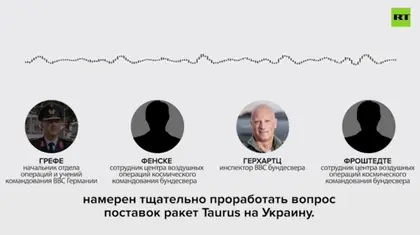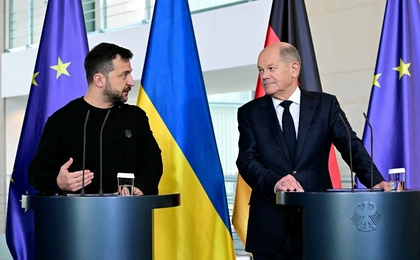Kyiv Post reported that Margarita Simonyan, editor-in-chief of Russia’s RT television channel, said on Thursday she had an audio recording of high-ranking Bundeswehr officers discussing strikes on the Crimean Bridge.
On Friday she said she felt she had to responded to those who did not believe in the authenticity of the recording to prove it existed, saying: “This audio speaks for itself. At first, when I just published the first text about the existence of such audio, there were many skeptics. And the media called me and wrote: ‘No, it can’t be.’ This is the real audio.”
JOIN US ON TELEGRAM
Follow our coverage of the war on the @Kyivpost_official.
She published on her VKontakte channel what she said was a complete transcript of the conversation between four high-ranking Bundeswehr officers that took place Feb. 19, 2024. The men were identified as Air Force Command Chief of Operations and Exercises Frank Graefe, Bundeswehr Air Force Inspector Ingo Gerhartz and Space Command Air Operations Center staff Fenske and Frostedte.
The transcript of the conversation can be seen here.
After having reviewed the transcript, which does indeed talk about how the Kerch Bridge could be attacked by using Germany’s long-range Taurus cruise missiles, it seems more likely to be a brainstorming session between commanders and technical experts rather than a conspiracy to carry out a clandestine attack on the link to mainland Russia.

Scraping Bottom – Film Studio Donates Soviet-Era Tanks to Russia’s Army
Kyiv Post has not been able to independently verify the authenticity of the audio recording. In any event, Simonyan appears to be executing the task of propagandists the world over: getting as much mileage from a story as possible.
The discussion begins with Gerhartz setting the scene: “As you have already heard, Defense Minister Pistorius intends to carefully consider the issue of supplying Taurus missiles to Ukraine.”
He then says that no one knows why Scholz is blocking the transfer, but he has a meeting with Pistorius planned and needs to be prepared to brief the minister on the political, technical and operational issues involved should the decision to give the missiles be made.
He then tasks Fenske to produce a short presentation that will identify key aspects related to the transfer should it go ahead, addressing such things as the missiles’ capabilities, how they could be transported to Ukraine, what would need to be done to prepare Ukrainian operators, and what modifications would need to be made to the launching aircraft. He also asks how the missile manufacturer MBDA could be involved.
According to Gerhartz, the manufacturer says the launching aircraft makes little difference, that it would take six months to modify and prepare the aircraft and missiles “no matter whether it is a Sukhoi or an F-16.”
Graefe then initiates a discussion about the options for training, delivery times and how long it would be needed to prepare Ukraine to receive and operate the weapons. “This part of the training can take place in Germany. When the first missiles are delivered, we need to make quick decisions regarding mountings and training. We may have to turn to the British on these issues and take advantage of their know-how.”
He also says that once the Chancellor decides to supply the missiles to Ukraine, which will be transferred from the Bundeswehr, they won’t be ready for use for another eight months.
Fenske then talks about how the training requirement and the time needed to deliver it will be driven by Ukraine’s intended targets. He suggests that this could best be achieved by deploying German assistance on site initially and suggests this could be done by a covert deployment from Poland.
Graefe stamps on that quite quickly and says it’s a red line. “We need to make sure that from the very beginning there is no language that makes us a party to the conflict… if we now tell the minister that we will schedule meetings and travel by car from Poland so that no one notices, this is already participation, we will not do this.” He suggests that MBDA should be approached to see if they could do the in-country work.
Gerhartz is also of the opinion that the German military should not be seen to be directly involved in any mission planning. This should be solely carried out by Ukrainians. He does, however, suggest seconding military staff to MBDA: “Thus, direct communication with Ukraine will only be through MBDA, this is much better than if such a connection exists with our Air Force.”
Graefe considers that option to be untenable and politically unacceptable as well.
The subject of the bridge first comes up in a discussion on what targets Ukraine will most likely want to attack. Hitting objectives such as ammunition depots or headquarters complexes would be large targets and might not need as much operator expertise as hitting a target such as a bridge, which has a much narrower profile. This would again have an impact on preparation times.
Gerhartz says: “We all know that they [the Ukrainians] want to destroy the bridge… not only because it has important military-strategic, but also political significance.
Fenske says they have intensively studied this issue and, unfortunately, came to the conclusion that the bridge, due to its size, is similar to a runway and if the aim is to destroy the bridge rather than just put holes in it, that would “require 10 or even 20 missiles.”
The discussion took place more than a week before German Chancellor Olaf Scholz once again signaled that he did not support passing the weapons to Kyiv. The discussion is not, as the Russians have suggested, a planning session but merely senior officers discussing options in readiness for being asked questions by their political masters in Berlin.
You can also highlight the text and press Ctrl + Enter






